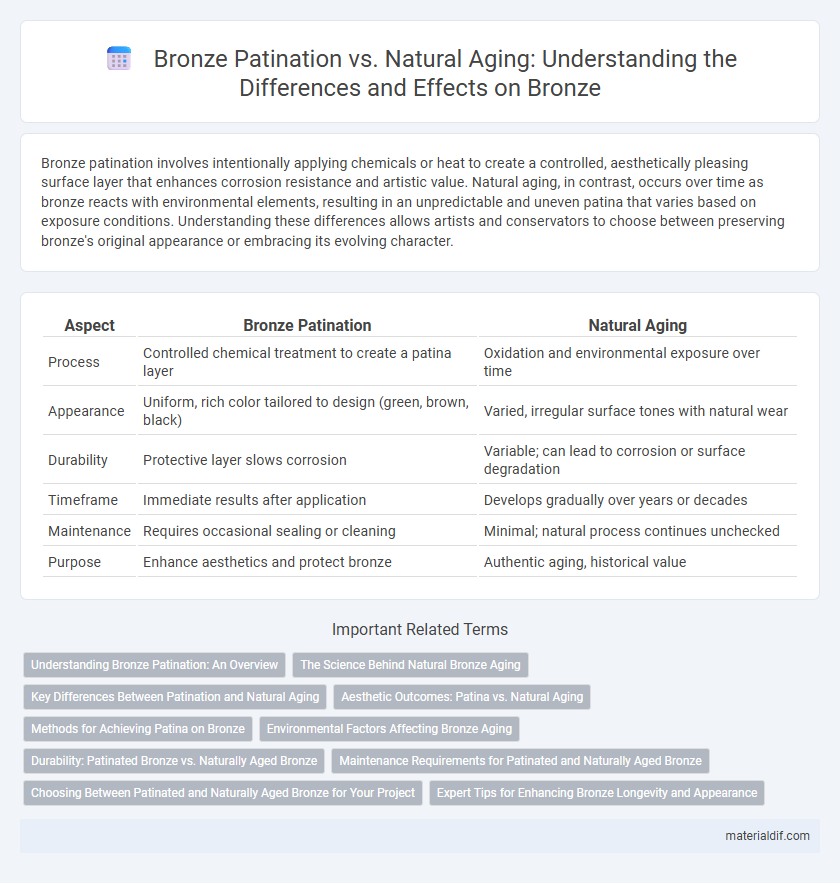Bronze patination involves intentionally applying chemicals or heat to create a controlled, aesthetically pleasing surface layer that enhances corrosion resistance and artistic value. Natural aging, in contrast, occurs over time as bronze reacts with environmental elements, resulting in an unpredictable and uneven patina that varies based on exposure conditions. Understanding these differences allows artists and conservators to choose between preserving bronze's original appearance or embracing its evolving character.
Table of Comparison
| Aspect | Bronze Patination | Natural Aging |
|---|---|---|
| Process | Controlled chemical treatment to create a patina layer | Oxidation and environmental exposure over time |
| Appearance | Uniform, rich color tailored to design (green, brown, black) | Varied, irregular surface tones with natural wear |
| Durability | Protective layer slows corrosion | Variable; can lead to corrosion or surface degradation |
| Timeframe | Immediate results after application | Develops gradually over years or decades |
| Maintenance | Requires occasional sealing or cleaning | Minimal; natural process continues unchecked |
| Purpose | Enhance aesthetics and protect bronze | Authentic aging, historical value |
Understanding Bronze Patination: An Overview
Bronze patination involves the deliberate application of chemicals or heat to create a protective and aesthetically valued surface layer, enhancing the metal's corrosion resistance and visual appeal. Natural aging of bronze occurs over time through exposure to atmospheric elements and pollutants, resulting in an irregular and often less controlled patina. Understanding the differences in chemical composition, texture, and color between artificially patinated bronze and naturally aged bronze is crucial for conservation and artistic applications.
The Science Behind Natural Bronze Aging
Natural bronze aging results from a complex chemical process where copper in the alloy reacts with oxygen, moisture, and pollutants to form a stable patina. This patina, primarily composed of copper carbonate and copper sulfate, acts as a protective layer that prevents further corrosion. The science behind natural bronze aging involves gradual oxidation and environmental interactions that create unique colors and textures over time.
Key Differences Between Patination and Natural Aging
Bronze patination involves the deliberate application of chemicals or heat to create a controlled surface finish that enhances color and texture, while natural aging occurs as a spontaneous result of environmental exposure, developing a unique and unpredictable patina over time. Patination provides an immediate and uniform appearance often desired for aesthetic purposes, whereas natural aging reflects the organic wear and oxidation processes influenced by humidity, air quality, and handling. The key difference lies in intentionality and timing: patination is a crafted alteration, whereas natural aging is an ongoing, passive transformation of bronze surfaces.
Aesthetic Outcomes: Patina vs. Natural Aging
Bronze patination involves applying chemical treatments to create a controlled surface color and texture, enhancing the aesthetic appeal with rich greens, browns, or blues that emphasize artistic intent. Natural aging produces a patina through oxidation over time, offering an organic, unpredictable finish that reflects environmental exposure and history. Patination provides a customizable, uniform appearance, whereas natural aging results in unique, varied patterns that highlight authenticity and the passage of time.
Methods for Achieving Patina on Bronze
Patination on bronze can be achieved through chemical treatments using acids, liver of sulfur, or cupric nitrate, which accelerate surface oxidation to produce varied colors like green, blue, or brown. Natural aging involves prolonged exposure to environmental elements such as moisture, air, and pollutants, allowing a gradual development of patina that offers organic texture and tone. Controlled heating and application of waxes or oils also enhance the patina's depth and protection while preserving the bronze's aesthetic qualities.
Environmental Factors Affecting Bronze Aging
Bronze patination and natural aging of bronze are heavily influenced by environmental factors such as humidity, temperature, and exposure to pollutants like sulfur dioxide and chlorides. High humidity and acidic pollutants accelerate the formation of greenish-blue copper carbonate compounds known as verdigris, which contributes to the characteristic bronze patina. Conversely, dry and stable conditions slow down corrosion processes, allowing for more gradual and uniform natural aging of bronze surfaces.
Durability: Patinated Bronze vs. Naturally Aged Bronze
Patinated bronze exhibits enhanced durability due to its controlled chemical surface treatment, forming a protective layer that resists corrosion and environmental damage more effectively than naturally aged bronze. Natural aging relies on uncontrolled oxidation, which can result in uneven patina and potential weakening of the metal over time. Consequently, patinated bronze maintains structural integrity and aesthetic appeal longer in harsh outdoor conditions compared to naturally aged bronze.
Maintenance Requirements for Patinated and Naturally Aged Bronze
Patinated bronze requires regular maintenance to preserve its protective chemical coating, including gentle cleaning and occasional application of wax or sealants to prevent corrosion. Naturally aged bronze develops a stable patina through environmental exposure, generally demanding less frequent upkeep but still benefiting from periodic inspection to avoid deterioration. Maintenance strategies should prioritize the specific characteristics of each surface to ensure longevity and aesthetic integrity.
Choosing Between Patinated and Naturally Aged Bronze for Your Project
Choosing between patinated and naturally aged bronze depends on your project's desired aesthetic and timeline. Patinated bronze offers a controlled, customizable finish with vibrant colors and textures achieved through chemical treatments, ideal for immediate visual impact. Naturally aged bronze develops a unique, organic patina over time, providing authenticity and gradual color evolution influenced by environmental factors.
Expert Tips for Enhancing Bronze Longevity and Appearance
Bronze patination involves applying chemical treatments to develop a protective and aesthetically appealing surface, enhancing corrosion resistance and color depth. Natural aging allows bronze to develop a unique, weathered look over time, with a protective oxide layer forming through exposure to air and moisture. Experts recommend controlled patination combined with regular cleaning and sealing to maintain bronze's longevity and visual appeal while preserving its character.
Bronze Patination vs Natural Aging Infographic

 materialdif.com
materialdif.com